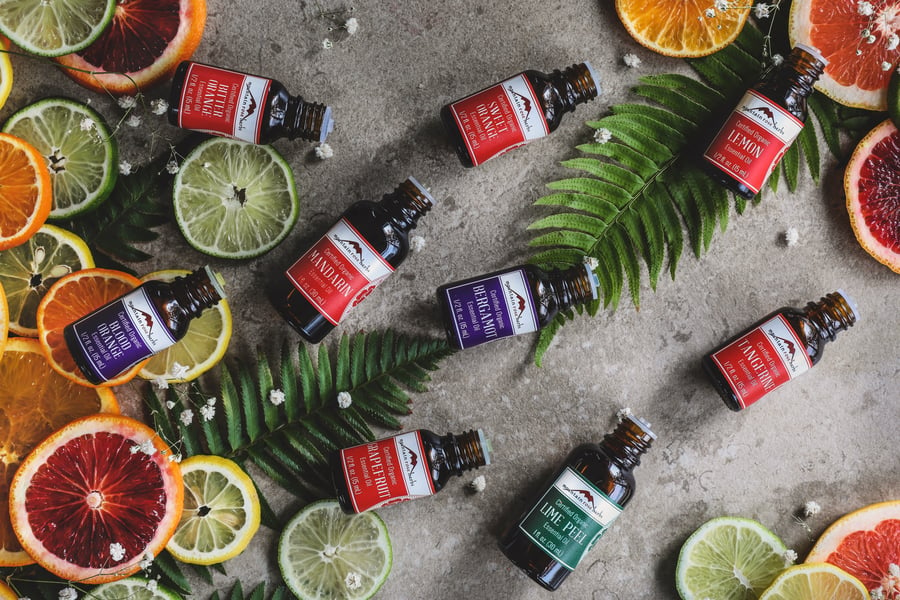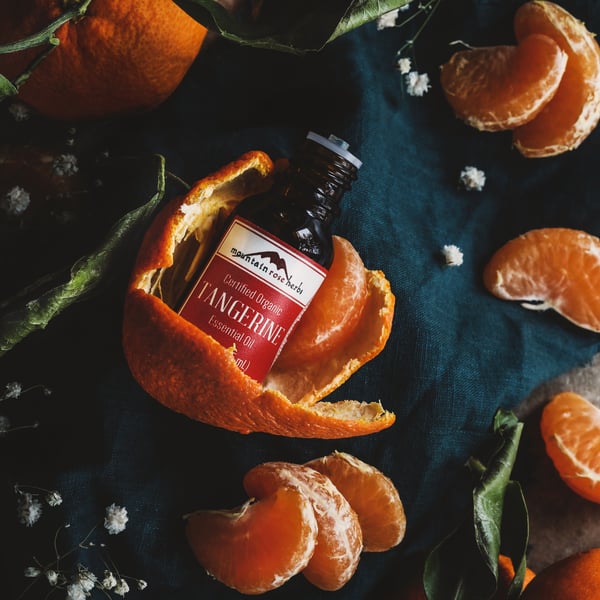Citrus essential oils are bright, sweet, and sour and are known to bring a smile to your face. They are energetically uplifting and engaging and pack a punch in DIY cleaning products. But which one should you use?
Organic citrus oils are cold-pressed from the fruit peel of various citrus trees. These lovely essential oils are mostly made up of the same constituents but vary in the amounts that they contain. (+)-Limonene is the primary monoterpene in all of them and contributes to their use in surface cleaners, room sprays, and soaps.
Blending Citrus Essential Oils
All citrus peel oils are considered top notes and evaporate quickly. When blending we recommend using a subtle base note like nutmeg or copaiba balsam that will not overpower the citrus aroma. You can blend citrus together to make a unique shiny scent. They also blend well with floral oils like lavender, other bright oils like peppermint or rosemary, and spice oils like cinnamon or clove.
Storage and Shelf Life
Because of their cold-pressed nature, citrus oils do have a shorter shelf life than most essential oils. We recommend using them up within 1-2 years of purchase. They can be stored in the refrigerator to increase the life of the oil. Due to the (+)-limonene content, these oils can also oxidize quickly. Oxidized oils can cause skin sensitization and should not be used topically. However, they could still be added to cleaning formulas.

Introduction to the Citrus Oils
With so many oils to choose from, we always recommend using your nose. With citrus, it is good to know if you prefer sweet or bitter, sour, or sugary. They are all slightly different and using an oil that you like is usually best. The notes below contain aroma descriptions, major constituents, and data on phototoxicity.
ORGANIC BERGAMOT ESSENTIAL OIL
- Botanical Name: Citrus bergamia
- Aroma: Dry citrus that is bitter and slightly sour with subtle floral top notes.
- Appearance: Clear or colorless.
- Uses: We love bergamot in soaps and room sprays. It is mostly used for fragrance.
- The bergamot oil that we offer is bergapten-free or furanocoumarin-free. This constituent is extremely phototoxic, and removing it provides a safer oil. Because the bergapten is removed from the oil, it is generally considered safe. Bergamot contains up to 45% (+)-limonene, 28% linalyl acetate, and 20% linalool.
Organic Lime essential oil
- Botanical Name: Citrus aruantifolia
- Aroma: Tart, sour citrus that has a fresh and bright top note.
- Appearance: Translucent yellow-green.
- Uses: With a complex aroma, lime is best saved for room sprays and diffusion.
- Another favorite for those who like sour citrus. Mexican-type lime oil contains up to 48% (+)-limonene, 21% β-pinene, and 8% γ-terpinene. There is also a Persian-type lime oil available that is pressed from Citrus latifolia. Lime oil is phototoxic and should be avoided topically if spending time outside. Similar to lemon oil, there is distilled oil on the market that is clear in color and has a very sweet and candy-like aroma.
Organic Lemon essential oil
- Botanical Name: Citrus x limon
- Aroma: Slightly sugary citrus that has strong sour notes characteristic of fresh lemon.
- Appearance: Translucent yellow.
- Uses: Lemon is a classic addition to DIY cleaning recipes and useful for sticky messes on the counter.
- A more well-known citrus oil, lemon has a bright fresh scent. It contains up to 76% (+)-limonene, 17% β-pinene, and 13% γ-terpinene. This is another low-risk phototoxic oil. There is distilled lemon oil available. It is colorless and has a much sweeter scent than cold-pressed oil. Distilled citrus peel oils are often used for fragrance blends.
Organic Grapefruit essential oil
- Botanical Name: Citrus paradisi
- Aroma: Fresh and tangy citrus that smells like cutting into a juicy grapefruit.
- Appearance: Translucent yellow.
- Uses: Grapefruit is great in fragrance and diffuser blends, and packs an extra punch in surface cleaners.
- We love white grapefruit essential oil! It is perfect for those who prefer slightly sour citrus. Grapefruit is mostly made up of (+)-limonene, containing up to 95%. It is considered a low-risk phototoxic oil and should be avoided topically if going out in the sun.
Organic Mandarin essential oil
- Botanical Name: Citrus reticulate
- Aroma: Light, fruity citrus that is slightly sweet.
- Appearance: Dark burnt green to amber.
- Uses: This subtler citrus is lovely in body sprays and skin care products.
- Mandarin is a perfectly balanced citrus that is not too sweet and not too sour. Our green mandarin essential oil contains up to 74% (+)-limonene, 22% γ-terpinene, and around 2% of both β-pinene and α-pinene. The furanocoumarin content is not sufficient enough to be phototoxic, making this oil generally considered safe for use.
organic Sweet Orange Essential Oil
- Botanical Name: Citrus sinensis
- Aroma: Sweet and bright sugary citrus.
- Appearance: Translucent orange.
- Uses: Sweet orange is the classic citrus found in cleaning products. It is also found in a lot of bathroom sprays for its sweet and refreshing scent.
- This quintessential citrus is by far the most well-known. It is sweet and sugary with no sour notes. Our American-type oil can contain up to 95% (+)-limonene! Followed by β-myrcene and α-pinene. There are no known precautions and sweet orange oil is not phototoxic.
Organic Bitter Orange essential oil
- Botanical Name: Citrus aurantium
- Aroma: Dry citrus that has bitter top notes that complemented by a faintly sweet base.
- Appearance: Almost colorless, pale yellow.
- Uses: Another great citrus oil for cleaning products. Bitter orange is not as widely used as other citrus oils, but still a joy to have around.
- Bitter orange is a drier citrus that seems subdued compared to some of the bright oils like sweet orange and lemon. It can contain up to 94% (+)-limonene, 2% β-myrcene, and 2% linalool. It is a low-risk phototoxic oil.
Organic Tangerine essential oil
- Botanical Name: Citrus reticulata
- Aroma: Sweet bright citrus that is orange-like but not as sugary.
- Appearance: Translucent dark orange.
- Uses: Tangerine is mostly used in fragrance and diffusion. It is safe for body care products as well.
- The tangerine is a type of mandarin and they share the same botanical name. However, tangerine oil has a stronger sweeter scent than the mandarin that we offer. Tangerine oil contains up to 91% (+)-limonene, 4.5% γ-terpinene, and 3% β-myrcene. It is not considered phototoxic.
ORGANIC BLOOD ORANGE ESSENTIAL OIL
- Botanical Name: Citrus sinensis
- Aroma: Fresh orange peel with notes of sweet, tart berries.
- Appearance:Translucent dark orange-red.
- Uses: Blood orange can be used for fragrance and diffusion, and can be added to body care and cleaning formulas. Noted for its ability to support a positive mood, its high limonene content also makes it a natural degreaser.
- Blood oranges are similar in appearance to other oranges, but the flesh within the peel is a deep shade of raspberry red. Blood orange oil contains up to 95% (+)-limonene, and includes myrcene and a-pinene. It is not considered phototoxic.
Ready to jump into blending with citrus essential oils?
Try This Ginger Citrus Body Spray Recipe!
You may also enjoy:
Caution: Essential oils are generally not indicated for use with infants or young children, those who are pregnant or breastfeeding, people with serious medical conditions, or certain pets—especially cats. The National Association for Holistic Aromatherapy has an excellent webpage on safety information for essential oils and is a wonderful resource.
References: Constituent and phototoxic notes
Tisserand, R. and Young, R. (2014) Essential Oil Safety Second Edition.















